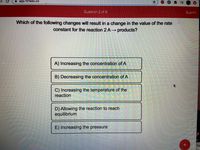
Chemistry
10th Edition
ISBN: 9781305957404
Author: Steven S. Zumdahl, Susan A. Zumdahl, Donald J. DeCoste
Publisher: Cengage Learning
expand_more
expand_more
format_list_bulleted
Question

Transcribed Image Text:app.101edu.co
キ三
Question 2 of 8
Submit
Which of the following changes will result in a change in the value of the rate
constant for the reaction 2 A→ products?
A) Increasing the concentration of A
B) Decreasing the concentration of A
C) Increasing the temperature of the
reaction
D) Allowing the reaction to reach
equilibrium
E) Increasing the pressure
at
"Ho
Expert Solution
This question has been solved!
Explore an expertly crafted, step-by-step solution for a thorough understanding of key concepts.
This is a popular solution
Trending nowThis is a popular solution!
Step by stepSolved in 4 steps with 2 images

Knowledge Booster
Learn more about
Need a deep-dive on the concept behind this application? Look no further. Learn more about this topic, chemistry and related others by exploring similar questions and additional content below.Similar questions
- For a reaction A+B 2 AB, if the initial concentration of A is 2.00 M, B is 1.80 M and AB is OM and the equilibrium concentration of AB is 0.02 M. Select all statements that are TRUE. O The concentration of A at equilibrium is 2.00 M. O To calculate the Keg for this reaction, we can use (A]=2.00 M, [B]= 1.80 M and (AB]=0.02 M to solve for it. O The concentration of B at equilibrium is 1.78 M. O The Keq will be much larger than 1 and this reaction favor the formation of the product. O The change in concentration, x, is equal to 0.02 M.arrow_forwardThe following reaction is exothermic: 3A(g) B(g) + C(g) Gaseous argon is added to the equilibrium mixture without change in volume or temperature. Predict the effect of the possible stress mentioned directly above on the reaction mixture by selecting the correct phrase bel shift right to attain chemical equilibrium no shift to attain chemical equilibrium shift left to attain chemical equilibrium Onot enough information to answer question Previous DELL II O O O Oarrow_forwardCatalysts increase reaction rates by _____ A) increasing the activation energy. B) increasing the enthalpy of reaction. C) decreasing the enthalpy of reaction. D) providing an alternate reaction mechanism with a lower activation energy. E) changing the value of the equilibrium constant.arrow_forward
- Question 17 A chemistry student wants to speed up her reaction. Which of the following would be the best ways for her to do this? Select all that apply. Select 3 correct answer(s) | Increase the amount of product | Increase the amount of reactant Add a catalyst Decrease the temperature Increase the temperaturearrow_forwardConsider the reaction: A ←--→ B At equilibrium, what can be said about the concentration of A and B? Explain (note: the numerical value of the equilibrium constant changes with temperature).arrow_forward26) pls help very urgentarrow_forward
- Consider the reaction below. 3.28 mol of A and 10.5 mol of B are added to a 3.00 L container. At equilibrium, the concentration of A is 0.743 M. What is the concentration of at equilibrium? (complete chart) 1 A + 2 B ↔↔ 3 C --------- 1 A + 2 B ↔↔ 3 C Initial M M M Change - M - M + M Equilibrium 0.743 M M M Use the concentrations above to calculate the equilibrium constant for this reaction: Keq = ?arrow_forwardPlease don't provide handwriting solutionarrow_forwardPlease answer fast!arrow_forward
arrow_back_ios
SEE MORE QUESTIONS
arrow_forward_ios
Recommended textbooks for you
 ChemistryChemistryISBN:9781305957404Author:Steven S. Zumdahl, Susan A. Zumdahl, Donald J. DeCostePublisher:Cengage Learning
ChemistryChemistryISBN:9781305957404Author:Steven S. Zumdahl, Susan A. Zumdahl, Donald J. DeCostePublisher:Cengage Learning ChemistryChemistryISBN:9781259911156Author:Raymond Chang Dr., Jason Overby ProfessorPublisher:McGraw-Hill Education
ChemistryChemistryISBN:9781259911156Author:Raymond Chang Dr., Jason Overby ProfessorPublisher:McGraw-Hill Education Principles of Instrumental AnalysisChemistryISBN:9781305577213Author:Douglas A. Skoog, F. James Holler, Stanley R. CrouchPublisher:Cengage Learning
Principles of Instrumental AnalysisChemistryISBN:9781305577213Author:Douglas A. Skoog, F. James Holler, Stanley R. CrouchPublisher:Cengage Learning Organic ChemistryChemistryISBN:9780078021558Author:Janice Gorzynski Smith Dr.Publisher:McGraw-Hill Education
Organic ChemistryChemistryISBN:9780078021558Author:Janice Gorzynski Smith Dr.Publisher:McGraw-Hill Education Chemistry: Principles and ReactionsChemistryISBN:9781305079373Author:William L. Masterton, Cecile N. HurleyPublisher:Cengage Learning
Chemistry: Principles and ReactionsChemistryISBN:9781305079373Author:William L. Masterton, Cecile N. HurleyPublisher:Cengage Learning Elementary Principles of Chemical Processes, Bind...ChemistryISBN:9781118431221Author:Richard M. Felder, Ronald W. Rousseau, Lisa G. BullardPublisher:WILEY
Elementary Principles of Chemical Processes, Bind...ChemistryISBN:9781118431221Author:Richard M. Felder, Ronald W. Rousseau, Lisa G. BullardPublisher:WILEY

Chemistry
Chemistry
ISBN:9781305957404
Author:Steven S. Zumdahl, Susan A. Zumdahl, Donald J. DeCoste
Publisher:Cengage Learning

Chemistry
Chemistry
ISBN:9781259911156
Author:Raymond Chang Dr., Jason Overby Professor
Publisher:McGraw-Hill Education

Principles of Instrumental Analysis
Chemistry
ISBN:9781305577213
Author:Douglas A. Skoog, F. James Holler, Stanley R. Crouch
Publisher:Cengage Learning

Organic Chemistry
Chemistry
ISBN:9780078021558
Author:Janice Gorzynski Smith Dr.
Publisher:McGraw-Hill Education

Chemistry: Principles and Reactions
Chemistry
ISBN:9781305079373
Author:William L. Masterton, Cecile N. Hurley
Publisher:Cengage Learning

Elementary Principles of Chemical Processes, Bind...
Chemistry
ISBN:9781118431221
Author:Richard M. Felder, Ronald W. Rousseau, Lisa G. Bullard
Publisher:WILEY